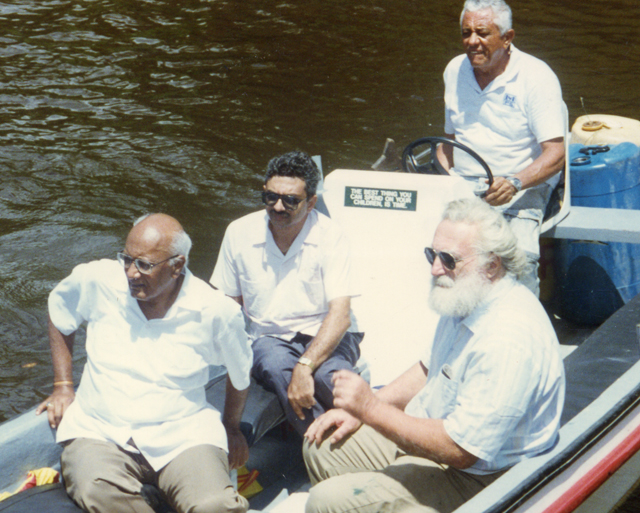HEADING
A Guyana experience
By Bishop Benedict Singh
April 2000
Return to Table of Contents
Print Article
Guyana, in South America, may have discovered the way ahead for the Church of the third millennium. In the years that are dawning, it seems that the laity will be playing a much greater role than in centuries past.
 Bishop Singh (front left) and Scarboro missionary Fr. Al Feliz (fromt right) on their way to celebrate Mass in the village of Sipauta, Guyana. Fr. Al passed away in Guyana last year.
Bishop Singh (front left) and Scarboro missionary Fr. Al Feliz (fromt right) on their way to celebrate Mass in the village of Sipauta, Guyana. Fr. Al passed away in Guyana last year.
In some countries, because of the shortage of priests, the Church is cutting down on the number of parishes or amalgamating parishes, putting one priest in charge of two or three parishes. This could never happen in Guyana because lay people are stepping in to make up for the shortage of priests.
People who remember Guyana in past times now recognize a new emerging Church. In the past, the Church depended on the priest for everything. Now it is almost the opposite—the priest depends on the people in nearly every aspect of the Church’s life.
In the interior of the country, there is a vast area of mountain and savannahs (prairies) inhabited by many of the original peoples of Guyana, the Amerindians. There are nine tribes, most of whom are Catholics evangelized in the early days of the last century. The four priests serving these people are only able to visit each village a few times a year. However, every village has its team of Parish Lay Assistants (PLAs) who give life to the Church.
Besides doing the Sunday services, these PLAs supervise baptismal and marriage preparations, gather the people together as a community, try to solve any disputes that may arise, and serve as Eucharistic ministers. They also care for the sick members of the village and perform funeral services for any who die.
These PLAs are trained at annual seminars, making a promise to serve for one year at the end of these seminars. A few are more highly trained, attending a three-month course and serving for three years. They travel around to the villages, supervising those less trained. One of their duties is to baptize babies after the parents have completed the baptismal course. However, they are not able to witness marriages as civil law would not allow this.
TODAY THE PRIEST DEPENDS ON THE PEOPLE IN NEARLY EVERY ASPECT OF THE CHURCH’S LIFE.
There is another area of forests and vast rivers where three priests serve 34 villages. Again, it is the PLAs in each settlement who keep the Church active. The priests travel around by boat or land-rover; and at their headquarters run seminars and training sessions for the PLAs.
In the more populated parts of Guyana, where a priest may have four or more parishes to look after, it is also the laity who make this possible. The diocese, too, has its catechetical team run by lay people, one of whom holds a degree in theology. There is also a team of catechists, a team to coordinate the readings at Mass, and the parish councils. Marriage Encounter, Engaged Encounter and many other organizations of lay people also take an active part in the life of the Church.
Scarboro in Guyana
The Scarboro Fathers came to Guyana almost 50 years ago, in 1953. This followed from a nationwide tour by Scarboro missionary Fr. Patrick Moore with his famous statue of Our Lady of Fatima. The coming of the Scarboro Fathers was, we might say, a thankful gift from Our Lady.
The Scarboro priests had been turned out of China, together with Bishop Kenneth Turner, and found a new mission field here. They set up a parish, Our Lady of Fatima, in Georgetown and took on a large section of the country, known as the Corentyne—a predominantly Hindu and Muslim area. Up to that time there had been only Jesuits and a few diocesan priests.
Presently, due to the small number of priests, strenuous efforts are being made to promote vocations to the priesthood so as to ensure that our Catholic communities remain truly Eucharistic communities.
Guyana is inhabited by six different races, and this plays an important part in the life of the Church and the nation. The two predominant races are the Afro-Guyanese (of African ancestry) and the Indo-Guyanese (of Indian ancestry).
Guyana became an independent country in 1966. Since then there has been a history of politically motivated confrontation between the two major races, which has held up economic progress and development.
The Catholic Church, more than any other Church or religion, embraces members of all races. It has an important work to do in bringing all people to live together in peace.
The motto of Guyana is: “One People, One Nation, One Destiny.” That is the great challenge for the Church of the future.
SCARBORO PRIEST & LAY MISSIONARIES TO GUYANA
Since 1953, 37 Scarboro priests and seven lay missioners have served in this South American country.
Wally Chisholm, Graham Clark, Armie Clement, Stan Desroches, Joe Ernewein, Al Felix, John Gault, Jack Hawkshaw, Terry & Harry Heemskerk, Gerry Heffernan, Vince Heffernan, Pat Kelly, Basil Kirby, Bob Ling, Jack Lynch, Ed Lyons, Ken MacAulay, John & Jean MacInnis, Alex MacIntosh, Joe MacNamara, Tony Marsh, Ray McCarthy, Jack McIver, Scotty McKernan, Ed Moriarty, Joe Moriarty, Ted Morris, John O’Connor, Terry O’Donnell, Ron Pete, John Quinn, Ronald Reeves, Russ Sampson, Hugh Sharkey, Penelope Somerville, Don Swenson, Frank Thornley, Kenneth Turner, Peggy Velker, Linus Wall, Fred Wong, Joe Young.
Return to Table of Contents
Print Article